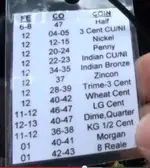jamiefind
Full Member
- Joined
- Oct 4, 2015
- Messages
- 102
- Reaction score
- 41
- Golden Thread
- 0
- Detector(s) used
- Garrett Ace 350, Garrett Pro Pointer AT, wireless ear receiver, Lesche digging tool & sod cutter, Lesche T-handle HD shovel, home-built 1/4" sifter
- Primary Interest:
- Relic Hunting
A lot of the higher end detectors tell you a number associated with your found target, but my Garrett ACE 350 just shows me a notch for the target (four different notches for iron, one for nickels, etc.). I'm an engineer by trade and would like to understand the technicalities of my machine better. Do these notches correspond with the number values shown on higher end machines? For example, does a target registering at number 72 equate to a particular notch on my machine? Any wisdom or education would be appreciated.
Upvote
0


